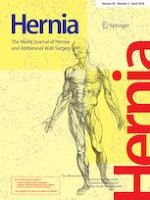Published in:

26-12-2023 | Diaphragmatic Hernia | Original Article
Causal relationship between cigarette smoking behaviors and the risk of hernias: a Mendelian randomization study
Authors:
Q. Wu, D. Yang, W. Dong, Z. Song, J. Yang, Y. Gu
Published in:
Hernia
|
Issue 2/2024
Login to get access
Abstract
Purpose
As the global population continues to age, there is a noticeable yearly rise in the incidence of hernias. Simultaneously, smoking, a widespread addictive behavior and a significant contributor to mortality, has evolved into a pervasive public health concern. Existing literature has already established a connection between smoking and an increased risk of postoperative recurrence and postoperative infections following hernia surgery. However, there remains a dearth of research exploring the association between smoking and hernia morbidity. In this study, our objective is to systematically evaluate the causal relationship between cigarette smoking behaviors and hernia morbidity using a Mendelian randomization (MR) approach.
Methods
Hernia-related data were sourced from the FinnGen Biobank database, while cigarette smoking behavior data were gathered from the GWAS and Sequencing Consortium of Alcohol and Nicotine Use. To assess the causal relationship, we employed five methods: the weighted median, the weighted mode the inverse variance weighted (IVW), MR-Egger, and the simple mode. Sensitivity analysis was conducted, incorporating Cochran's Q test, the MR-Egger intercept test, leave-one-out analysis, and funnel plot. The presentation of the causal relationship is expressed as an odds ratio (OR) along with their corresponding 95% confidence intervals (CI).
Results
Employing the IVW method as the reference standard, we found that smoking intensity is associated with an increased risk of diaphragmatic hernia (OR = 1.21, 95% CI 1.00–1.46, P = 0.047). These consistent findings were further corroborated by the weighted median and weighted mode methods (OR = 1.26, 95% CI 1.03–1.54, P = 0.026; OR = 1.25, 95% CI 1.02–1.52, P = 0.045). Conversely, when applying the IVW method, we identified no statistically significant causal relationship between smoking age, smoking initiation status, smoking cessation status, and the incidence of hernia.
Conclusions
Our MR study has uncovered genetic evidence linking smoking intensity and the occurrence of diaphragmatic hernia. The risk of developing diaphragmatic hernia rises in tandem with the intensity of smoking. This emphasizes the crucial role of regularly advising patients to cease smoking in clinical settings.